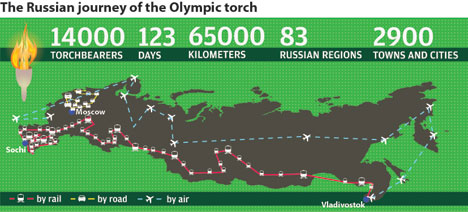Sochi Olympic firebird torch unveiled in Moscow

Russian World Champion in ice dancing Ilia Averbukh, left, and Olympic Champion in ice dancing Tatyana Navka present the Olympic torch for 2014 Sochi Winter Olympics, in Moscow. Source: AP Photo / Mikhail Metzel
The Sochi 2014 torch designers were tasked with conveying the concept of the Olympics Games, based on the idea of the convergence of Russian traditions and contemporary trends.
The torch resembles of a firebird feather, which is traditionally used in Russian fairytales to light the way; this “feather,” however, is made of cast aluminum alloy. The handle and central insert are molded from high-strength polymer. The torch weighs 1.8 kilograms (4 pounds) and is 0.95 meters (3 feet) in length. Its center of balance is perfectly positioned to make it easier for torchbearers to carry. The torch is designed to withstand adverse weather conditions, especially high winds and frosts.
Click to enlarge the infographics. Drawing by Alena Repkina.
The only difference between the Olympic and Paralympic torches is their color; the Olympic torch is red, while the Paralympic torch is sky-blue, symbolizing the power and spirit of the Olympic movement.
Olympic figure skating champion Tatiana Navka was the first to hold the brand new torch. “I think it’s so beautiful – red and silvery. I hope it will bring us luck in Sochi,” she said.
Also attending the ceremony were figure skater Ilia Averbukh, supermodel Natalia Vodianova and London Paralympic swimmer and gold medalist, Olesya Vladykina.
Related:
Counting down the days to Sochi 2014
Sochi Olympics ticket scalpers to face fines of up to $33,000
A total of 14,000 Olympic torches will be produced. A competition will decide who gets to carry the torch and wear the uniforms, which were especially designed for the participants of the Olympic relay.
“There will be no special terms for people who want to take part in the relay,” said Sochi 2014 Organizing Committee director, Dmitry Chernyshenko. “Anyone can take part.”
“The Sochi 2014 Olympic relay will involve more people and more locations than any other relay in the history of the Olympic movement,” Chernyshenko said. “It will run through 2,900 residential areas; we are designing the route so that 90 percent of the population will be able to come out and see the torch. The flame will be delivered to Elbrus, Lake Baikal and the North Pole. We also hope that it will travel to outer space.”
The Olympic torch relay: The facts
The lighting ceremony will take place in Greece, home of the Olympics. The torch will then be transported to Moscow in a special plane on October 7, 2013.
The Olympic relay will run through 2,900 residential areas, 83 Russian regions and all nine time-zones of the country – from Vladivostok to Kaliningrad.
Torchbearers will cover 65,000 kilometers (around 40,400 miles) in 123 days. There will be 14,000 torchbearers, and around 130 million Russians will have the chance to see the torch with their own eyes.
More than 30,000 volunteers will be involved. Each torchbearer will run between 200 and 300 meters (656-984 feet). The flame will travel 534 kilometers (330 miles) per day on average. The torches will be transported by air, train, road vehicles, traditional Russian troika and reindeer. The relay will finish in Sochi on February 2, 2014.
The Paralympic relay will travel through 50 Russian regions, from February 26, 2014 to March 7, 2014.
First published in Russian in Rossiyskaya Gazeta.
All rights reserved by Rossiyskaya Gazeta.
Subscribe
to our newsletter!
Get the week's best stories straight to your inbox
